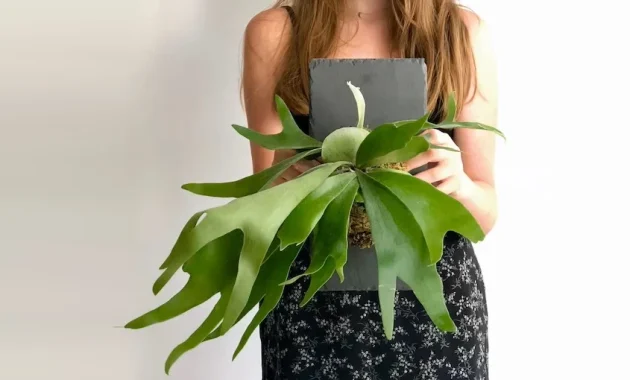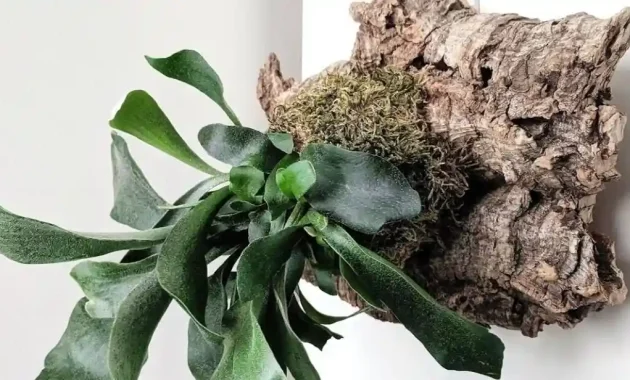Staghorn ferns, native to Africa, southern Asia, and parts of Australia, are epiphytic plants that can be easily mounted on rocks or other structures.
This article serves as a comprehensive guide to growing staghorn ferns on rocks, providing detailed instructions and care tips.
The mounting process involves using sphagnum moss as organic cushioning, which not only helps secure the ferns but also indicates when watering is required.
The moss is soaked, excess moisture is squeezed out, and then it is placed on the rock.
Fishing line, wire, plastic tubing, or plant tape can be used to bind the moss to the stone, and the fern is attached using the same method.
It is important to note that staghorn ferns should only be mounted outdoors in warm climates, as they are unable to withstand cold temperatures.
By following the steps outlined in this guide, one can create an attractive and natural display of these fascinating plants.
Key Takeaways
- Staghorn ferns are epiphytic plants that can grow on rocks and other low soil structures.
- Mounting staghorn ferns on rocks or boards mimics their natural growth.
- Sphagnum moss can be used as organic cushioning and also indicates when it’s time to water the plant.
- Staghorn ferns should only be mounted outdoors in warm climates, as they cannot survive cold temperatures.

What are Staghorn Ferns?
Staghorn ferns, native to Africa, southern Asia, and parts of Australia, are epiphytic plants that can be mounted on rocks, trees, or other low soil structures for display. These fascinating plants have various uses, including as decorative elements in gardens and homes.
There are different types of staghorn ferns, such as Platycerium bifurcatum and Platycerium superbum, each with its unique characteristics. These plants are known for their sterile basal leaves, called shields, and their foliar fronds, which can develop fuzzy brown growth that serves as reproductive structures.
In the wild, staghorn ferns can be found growing in old walls, crevasses in rock faces, and tree crotches. Mounting staghorn ferns on rocks allows them to mimic their natural growth and creates an attractive display.
By understanding the uses and types of staghorn ferns, individuals can explore the possibilities of incorporating them into their gardens or homes.
[youtube width=630 height=550]GUsVgTHmsUA[/youtube]
Mounting Process
The process of mounting staghorn ferns on various structures involves securing the plant to a chosen material using wire, fishing line, or other binding methods.
To successfully mount staghorn ferns on rocks, it is important to consider the type of rocks being used. Porous rocks, such as lava rocks or pumice stones, are ideal as they provide good air circulation and allow the fern’s roots to attach easily. Smooth rocks can also be used, but they may require additional materials such as moss or bark to provide a suitable surface for the fern to attach to.
In addition to rocks, alternative materials can be used for mounting staghorn ferns, such as driftwood, cork bark, or even old tree stumps. These materials provide a natural and aesthetically pleasing base for the ferns, allowing them to mimic their natural growth habits.
Care and Maintenance
Care and maintenance of mounted staghorn ferns involves regular monitoring of moisture levels and providing the necessary conditions for the fern to thrive. When it comes to watering, staghorn ferns should be watered when the sphagnum moss becomes dry. Overwatering should be avoided as it can lead to root rot.
It is important to check the moisture level regularly to ensure that the fern is not underwatered or overwatered. In addition to monitoring moisture levels, it is also crucial to be aware of common pests that may affect the fern. Common pests that can infest staghorn ferns include scale insects, mealybugs, and aphids.
Regular inspection of the plant can help identify any pest infestations early on, allowing for prompt treatment and prevention of damage to the fern.
Frequently Asked Questions
Can staghorn ferns be mounted on vertical walls indoors?
Yes, staghorn ferns can be mounted on vertical walls indoors. This method involves using nails and sphagnum moss to affix the fern to the wall. It is important to ensure the indoor environment provides the necessary warmth and conditions for the fern’s survival.
How often should staghorn ferns be watered when mounted on rocks?
When staghorn ferns are mounted on rocks, the watering frequency should be determined by the dryness of the sphagnum moss. It is important to water the ferns when the moss becomes dry to the touch, ensuring the best watering practices for their growth.
Can staghorn ferns be mounted on metal structures?
Staghorn ferns can be mounted on metal structures, such as hanging baskets, to provide a unique and attractive display. This method allows for the growth and development of the ferns while providing a sturdy support system for their foliage.
Do staghorn ferns require a specific type of lighting when mounted on rocks?
Staghorn ferns do not have specific lighting requirements when mounted on rocks. They are adaptable to various light conditions, but they prefer bright, indirect light. Alternative mounting options for staghorn ferns include driftwood and other materials.
Can staghorn ferns be mounted on living trees without harming the tree?
Living tree mounting of staghorn ferns is possible without harming the tree. By using materials like sphagnum moss and wire, the fern can be securely attached to the tree, mimicking its natural growth.


